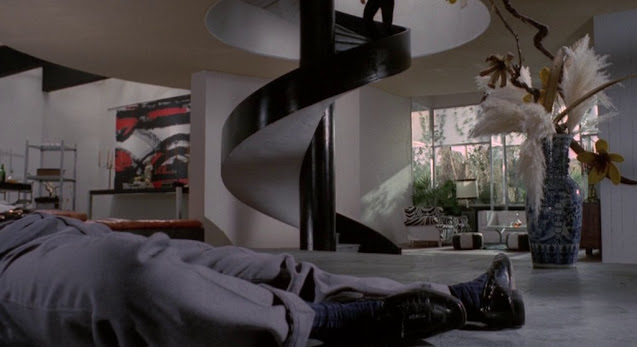In my previous post, I mentioned my intention to share briefer blog posts about various observations and discoveries I find in my day to day research on Italian cinema. However that post proved to be lengthier than anticipated. So, I’m back with a more concise update this time!
Hypnotic Crescendos initially served as a platform for sharing my insights into Italian genre cinema, with a specific focus on the design elements commonly found within these films. While I've examined the set designs of later-period gialli, I would say my interest in the aesthetics of the giallo stems from, and is primarily rooted within, the filone's most prolific and celebrated era, often referred to as the golden age of Italian genre cinema which spanned the mid to late 1960s through to the early to mid-1970s. During this era, the set designs of the giallo were influenced by the fashion trends of the late 1960s and early 1970s. These styles captured the cultural zeitgeist of the period, celebrating Italian design. A noteworthy exemplar of this phenomenon is Mario Bava’s Five Dolls for an August Moon (Cinque bambole per la luna d’agosto, 1970), a coastal-set giallo that deftly adheres to the mystery style reminiscent of Agatha Christie. The film stands out as a prime example of a giallo unfolding predominantly within a singular location—a stunning coastal villa perched dramatically on a cliffside.
Mario Bava employed his signature illusionary techniques to create the exterior location, imparting the illusion of a villa that, in reality, did not occupy the cliffside as depicted in the film. Whereas, the coastal villa’s interiors, where the majority of the film unfolds, were shot at Dear Studios in Rome. The centrepiece of the set is the heart of the villa, a modernist open-plan living space, where a black lacquered spiral staircase dominates the space. Amidst the modernist aesthetics defining the coastal residence—marked by pristine white walls and open layouts—the spiral staircase is our key focal point, creating a sense of visual splendour that mirrors the opulence of the era. The villa evokes the sophistication of a fashionable 60s gallery, transforming the space into a canvas for the bourgeois pursuits of its inhabitants. Serving as a visually captivating backdrop, it helps to curate the film's distinctively stylish feel.
 |
| Cinque bambole per la luna d’agosto (Bava, 1970) |
However, Bava's film was not the sole production in 1970 to employ such a set. Carlo Tuzii’s Ciao Gulliver (1970), a socially conscious drama emblematic of the post-’68 protest cinema movement, seemingly repurposed the sets for Bava’s film. Given that both Five Dolls for an August Moon and Ciao Gulliver were produced and released in 1970, it’s conceivable that the same set was repurposed for both films, albeit with distinct visual treatments in each production. Under the direction of production designer, Giuseppe Aldrovandi, Five Dolls for an August Moon incorporated modernist architectural elements set against soft furnishings, intricate light fixtures such as chandeliers, and 1960s artworks, featuring a vibrant colour palette dominated by red and yellow hues. The inclusion of natural elements, including various plants, decorative dried wood arrangements, and encroaching exterior fauna, added a dynamic layer to the main interior space.
In contrast, Ciao Gulliver's production designer, Antonio Visone, elected for a different visual approach. While Bava's film unfolded within the opulent confines of a seaside villa for the wealthy, Ciao Gulliver repurposed the same interior to depict the domain of Enrico Maria Salerno's character, "Boss." Consequently, the interior underwent a transformation to embody a more corporate, business-like aesthetic characterised by stark and minimalist interiors. Visone's departure from the luxurious setting of Bava's film underscores the shared space's versatility, transitioning into a setting reflective of the sterile world in Ciao Gulliver. Despite these differences, commonalities persist. Notably, the aforementioned staircase remains a consistent feature, even in the starkly empty surroundings, adorned only with a lone plant and artwork. Additionally, the square grid-like doorway, once an entrance to a bedroom in Five Dolls for an August Moon, now serves as the portal to Boss' office in Ciao Gulliver.
 |
| Ciao Gulliver (Carlo Tuzii, 1970) |
In the broader exploration of Giuseppe Aldrovandi's production design for Mario Bava’s Five Dolls for an August Moon, another significant film to examine is Romolo Guerrieri's relationship comedy The Divorce (Il divorzio, 1970), starring Vittorio Gassman and Anita Ekberg. Released in the same pivotal year of 1970, The Divorce appears to have repurposed the set from the aforementioned Bava film, a connection underscored by the distinctive spiral staircase, now adorned with silver accents.
The Divorce exhibits a parallel set design to Five Dolls for an August Moon, albeit with subtle modifications, reinforcing the continuity of visual elements across these productions. Guided by the creative vision of production designer Dario Micheli, the set design in The Divorce diverges from the sparser aesthetic of Ciao Gulliver, aligning more harmoniously with the pop-art sensibility witnessed in Bava's Five Dolls for an August Moon. This emphasises the interconnectedness of design choices, offering an understanding of how visual motifs transcended individual films in the vibrant cinematic landscape of the early 1970s.
I look forward to exploring Ciao Gulliver and the film's unique visuals in the future but in this blog post, I hope to have provided some context into the captivating sets that defined Italian genre cinema in the early 1970s.
Additional Images












No comments:
Post a Comment